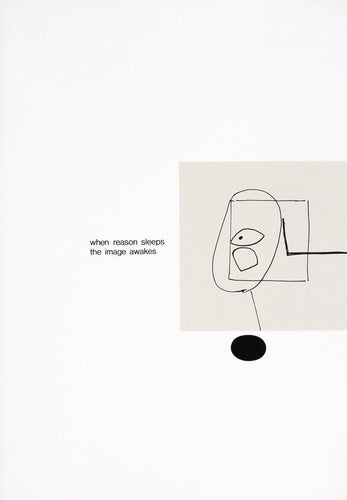‘It is Pasmore’s chief poetic gift that he can make the cosmic and the intimate one.’
Norbert Lynton
The artist’s search for abstract form is laid bare in this collaged maquette...
The critic William Hazlitt famously declared that in his stormy and refulgent scenes of ocean tumult, Turner had made ‘paintings of nothing, and very like’. He might as well have been describing the post-war work of Victor Pasmore. Hazlitt meant his words to sting, but for Pasmore they capture both the difficulty of his work – what is it, exactly, that we are looking at here? – and the source of that difficulty: Pasmore’s calculated, career-long inquiry into making abstract pictures without abstracting from nature.
Victor Pasmore, Points of Contact No 7 Maquette, collage
By the time Pasmore came to make his earliest prints, lithographs first in Stanley Jones’ Curwen Studio, then predominantly screenprints with Chris Prater, he had begun to refine the strange vocabulary of forms for which he is now so well known, but his approach to abstraction was as deliberate, slow, considered and wary as a cat stalking prey. An amateur evening-class painter who only took it up professionally in his 30s, Pasmore’s commitment to ‘Objective’ realism as co-founder of the Euston Road School of painting in 1937 was in part a double-down reaction to failed abstract experiments of the early 1930s (destroyed not long after their making). Far from the watershed event it was long been proclaimed to be, Pasmore’s arrival at his first successful ‘purely’ abstract paintings took him from a childhood book of Turner reproductions to the Impressionists and Post, to Cézanne, Van Gogh, Vuillard, Mondrian, and finally to Klee (with plenty of diversions in between), whose work had been shown at the Tate in 1945, just 5 years after his death. These influences Pasmore wore conspicuously on his sleeves. In the large scale retrospective exhibition of his work shown at Pallant House in 2017, you could actually see the murk and mist of the Thames slowly squared and rounded off, municipal groves dissolved into pointillist dot clouds, and Ravenscourt Park railings unbended into self-consuming spirals before your very eyes. Dissatisfied with painting, he made projecting reliefs in plastic, wood and metal, pieces that prompted commissions to work in urban design and ultimately led to the long-neglected Apollo Pavilion in the new town of Peterlee. Somewhat ironically, it was as if the more specific and narrow his use of form, the more avenues of exploration seemed to open up beyond him. Herbert Read dubbed Pasmore’s turn to abstraction ‘the most revolutionary event in postwar British art’, doing neither any favours in the process. For one thing, it failed to capture the tentativeness of Pasmore’s spidery approach, feeling his way toward an aesthetic conclusion that always seemed beyond his reach.
Victor Pasmore, Points of Contact No 3, 1965, original charcoal drawing
This small collaged maquette for Pasmore’s very first print was made at Curwen in 1965, just a year before Pasmore bought a house and studio in Malta, where he lived and worked until his death in 1998 and the light of the Mediterranean made itself known in his work in the jewelled blues and greens that enlarged his formally sombre palette. In this maquette, the elements that would be flattened by the lithographic process and appear suspended in animation, like a Calder mobile, here anxiously jostle and trip over one another. If Pasmore’s gifts could be reduced to one, it was his ability to work a composition into shape, bringing sometimes amorphous coalescences into harmonious suspension.
The print this maquette produced began Pasmore’s first extended series in print: Points of Contact. It is a deliberately doubly-meant title, drawing attention to points of similarity and departure from his painting, to nodes between the forms it contains and those found in the natural world – leaves, waves, clouds – and, in some of the prints, to the unbroken point of contact between the page and his spiralling line, like Klee’s famous dot that went for a walk.

Victor Pasmore at work in a restaurant on London's South Bank for the Festival of Britain, 6th January 1951, photographed by Charles Hewitt / Hutton Archive
The Image in Search of Itself was the title of a later series; essentially, these titles could be those of Pasmore’s career, in whose work lines, forms and space all seem in search of resolution. Paint sometimes looks like it has spilled over a surface, trickling in pursuit of a place to stop. Dense black clouds condense and self-swallow, like a lava lamp. This was generative, not essentialised form – or, as he put it, not ‘abstraction in front of nature, but a method of construction emanating from within.’ Like a piece of music, composed of formal elements which do not describe but elicit an emotional reaction, Pasmore hoped to bypass our usual fields of visual reference: ‘I do not paint directly from nature: I endeavour to paint in reaction to natural forms.’
Edward Rippingille, another of Turner’s contemporaries, once described watching the artist complete unfinished paintings on the important ‘varnishing days’ that preceded academy exhibitions, giving more organised painters the opportunity to fix any blemishes that had occurred to their work since their hanging. In front of paintings ‘without form and void, like chaos before the creation’, Turner appeared to theatrically improvise on the spot, transforming his colour fields into real ones. Looking at this collage, I wonder: is this how Pasmore might have worked his way toward a canvas? Collecting forms from the void and bringing them together, creation from chaos, until he had made ‘paintings of nothing, and very like.’











